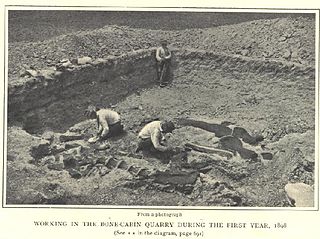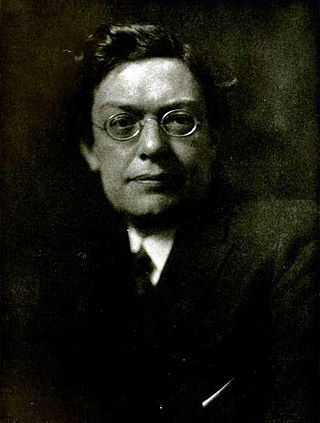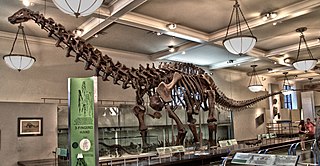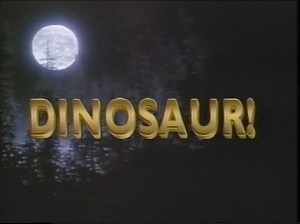Related Research Articles

Apatosaurus is a genus of herbivorous sauropod dinosaur that lived in North America during the Late Jurassic period. Othniel Charles Marsh described and named the first-known species, A. ajax, in 1877, and a second species, A. louisae, was discovered and named by William H. Holland in 1916. Apatosaurus lived about 152 to 151 million years ago (mya), during the late Kimmeridgian to early Tithonian age, and are now known from fossils in the Morrison Formation of modern-day Colorado, Oklahoma, New Mexico, Wyoming, and Utah in the United States. Apatosaurus had an average length of 21–23 m (69–75 ft), and an average mass of 16.4–22.4 t. A few specimens indicate a maximum length of 11–30% greater than average and a mass of approximately 33 t.

John Robert Horner is an American paleontologist most famous for describing Maiasaura, providing the first clear evidence that some dinosaurs cared for their young. In addition to his paleontological discoveries, Horner served as the technical advisor for the first five Jurassic Park films, had a cameo appearance in Jurassic World, and served as a partial inspiration for one of the lead characters of the franchise, Dr. Alan Grant. Horner studied at the University of Montana, although he did not complete his degree due to undiagnosed dyslexia, and was awarded a Doctorate in Science honoris causa. He retired from Montana State University on July 1, 2016, although he claims to have been pushed out of the Museum of the Rockies after having married an undergraduate student and now teaches as a Presidential Fellow at Chapman University.

Othniel Charles Marsh was an American professor of Paleontology in Yale College and President of the National Academy of Sciences. He was one of the preeminent scientists in the field of paleontology. Among his legacies are the discovery or description of dozens of new species and theories on the origins of birds.

John Harold Ostrom was an American paleontologist who revolutionized the modern understanding of dinosaurs. Ostrom's work inspired what his pupil Robert T. Bakker has termed a "dinosaur renaissance".

Brontosaurus is a genus of herbivorous sauropod dinosaur that lived in present-day United States during the Late Jurassic period. It was described by American paleontologist Othniel Charles Marsh in 1879, the type species being dubbed B. excelsus, based on a partial skeleton lacking a skull found in Como Bluff, Wyoming. In subsequent years, two more species of Brontosaurus were named: B. parvus in 1902 and B. yahnahpin in 1994. Brontosaurus lived about 156 to 146 million years ago (mya) during the Kimmeridgian and Tithonian ages in the Morrison Formation of what is now Utah and Wyoming. For decades, the animal was thought to have been a taxonomic synonym of its close relative Apatosaurus, but a 2015 study by Emmanuel Tschopp and colleagues found it to be distinct. It has seen widespread representation in popular culture, being the archetypal "long-necked" dinosaur in general media.

Bone Cabin Quarry is a dinosaur quarry that lay approximately 55 miles (89 km) northwest of Laramie, Wyoming, near historic Como Bluff. During the summer of 1897 Walter Granger, a paleontologist from the American Museum of Natural History, came upon a hillside littered with Jurassic period dinosaur bone fragments. Nearby was a sheepherder cabin built entirely out of fossil bones, hence the name "Bone Cabin Quarry." After Granger's discovery in late August 1897, the quarry was kept secret until early 1898, when the manpower could be amassed to undertake a full-scale excavation. Henry Fairfield Osborn, curator of the American Museum of Natural History headed the expedition. The bones of perfect skeletons lay thickly crowded. As of 1905, 483 parts of dinosaur were found, packed in 275 boxes with a weight of 100,000 pounds (45,000 kg). The excavation area was only 7,500 square feet (700 m2). Bone Cabin Quarry was excavated from 1898 until 1905, when the productivity of specimens thinned. Some of the dinosaurs found at the Bone Cabin Quarry include Stegosaurus, Allosaurus and Apatosaurus. Gargoyleosaurus is also known from the Bone Cabin Quarry West locality.

Tyrannosaurus rex is unique among dinosaurs in its place in modern culture; paleontologist Robert Bakker has called it "the most popular dinosaur among people of all ages, all cultures, and all nationalities". Paleontologists Mark Norell and Lowell Dingus have likewise called it "the most famous dinosaur of all times." Paleoartist Gregory S. Paul has called it "the theropod. [...] This is the public's favorite dinosaur [...] Even the formations it is found in have fantastic names like Hell Creek and Lance." Other paleontologists agree with that and note that whenever a museum erects a new skeleton or bring in an animatronic model, visitor numbers go up. "Jurassic Park and King Kong would not have been the same without it." In the public mind, T. rex sets the standard of what a dinosaur should be. Science writer Riley Black similarly states, "In all of prehistory, there is no animal that commands our attention quite like Tyrannosaurus rex, the king of the tyrant lizards. Since the time this dinosaur was officially named in 1905, the enormous carnivore has stood as the ultimate dinosaur."

Peter Lars Larson is an American fossil dealer who is head of the Black Hills Institute of Geological Research, which specialises in the excavation and preparation of fossils. He led the team that excavated "Sue", one of the largest and most complete specimens of Tyrannosaurus rex, which was the subject of a legal dispute resulting in its seizure and public auction. In 1996, Larson was convicted of customs violations related to failing to declare money he had brought from overseas as well as taking two fossils from federal land, and served 18 months in prison.

Charles Robert Knight was an American wildlife and paleoartist best known for his detailed paintings of dinosaurs and other prehistoric animals. His works have been reproduced in many books and are currently on display at several major museums in the United States. One of his most famous works is a mural of Tyrannosaurus and Triceratops, which helped establish the two dinosaurs as "mortal enemies" in popular culture. Working at a time when many fossil discoveries were fragmentary and dinosaur anatomy was not well understood, many of his illustrations have later been shown to be incorrect representations. Nevertheless, he has been hailed as "one of the great popularizers of the prehistoric past".

"Stan", also known by its inventory number BHI 3033, is a Tyrannosaurus rex fossil found in the Hell Creek Formation in South Dakota, just outside of Buffalo in 1987, and excavated in 1992. It is the fifth most complete T. rex fossil discovered to date, at more than 70% bulk. In October 2020, the fossil was sold for $31.8 million at auction, making it the most expensive dinosaur specimen and fossil ever sold. In March 2022 Abu Dhabi's Department of Culture and Tourism stated that they had acquired Stan and were planning on displaying the fossil at a new museum of natural history scheduled to open in 2025.

Tyrannosaurus is one of the most iconic dinosaurs and is known from numerous specimens, some of which have individually acquired notability due to their scientific significance and media coverage.

Apatosaurinae is a subfamily of diplodocid sauropods, an extinct group of large, quadrupedal dinosaurs, the other subfamily in Diplodocidae being Diplodocinae. Apatosaurines are distinguished by their more robust, stocky builds and shorter necks proportionally to the rest of their bodies. Several fairly complete specimens are known, giving a comprehensive view of apatosaurine anatomy.

Albertonykus is an alvarezsaurid dinosaur from the Maastrichtian-age rocks of the Horseshoe Canyon Formation of Alberta, Canada. It is known from forelimb and hindlimb remains from multiple individuals. All but two of the specimens come from a bonebed dominated by Albertosaurus, located at the top of Unit 4 of the Horseshoe Canyon Formation, dating to ~68.5 million years ago.

Dinosaur! is a 1985 American television documentary film about dinosaurs. It was first broadcast in the United States on November 5, 1985, on CBS. Directed by Robert Guenette and written by Steven Paul Mark, Dinosaur! was hosted by the American actor Christopher Reeve, who some years before had played the leading role of Superman.
Clash of the Dinosaurs is a four-part television mini-series produced by Dangerous LTD for Discovery Channel. The show premiered on December 6, 2009, with the first two episodes scheduled back-to-back.

Uncle Beazley is a life-size fiberglass statue of a Triceratops by Louis Paul Jonas. It is located near Lemur Island in the National Zoological Park in Northwest Washington, D.C., United States.

United States v. One Tyrannosaurus Bataar Skeleton (1:13−cv−00857) is a 2013 United States District Court for the Southern District of New York judgment regarding a requested order from the United States government to seize an imported Mongolian Tarbosaurus skeleton related to smuggling law and the applicability of Mongolian law in the United States.
Bolortsetseg Minjin is a Mongolian paleontologist known for her work in fossil repatriation and dinosaur-themed science outreach. She is a recipient of the WINGS WorldQuest Women of Discovery Award for Earth, National Geographic Explorer, and TEDx speaker. She is the founder of the Institute for the Study of Mongolian Dinosaurs.

Earl Douglass was an American paleontologist who discovered the dinosaur Apatosaurus, playing a central role in one of the most important fossil finds in North America. By 1922 Earl had unearthed and shipped more than 700,000 pounds of material including nearly 20 complete skeletons of Jurassic dinosaurs such as Diplodocus, Dryosaurus, Stegosaurus, Barosaurus, Camarasaurus and Brontosaurus.
Victoria Megan Arbour is a Canadian evolutionary biologist and vertebrate palaeontologist at Royal BC Museum, where she is Curator of Palaeontology. An "expert on the armoured dinosaurs known as ankylosaurs", Arbour analyzes fossils and creates 3-D computer models. She named the possible pterosaur Gwawinapterus from Hornby Island, and a partial ornithischian dinosaur from Sustut Basin, British Columbia, and has participated in the naming of the ankylosaurs Zuul, Zaraapelta, Crichtonpelta, and Ziapelta.
References
- ↑ "Queer voices in palaeontology". www.nature.com. Retrieved 18 February 2023.
- ↑ "Articles by Riley Black from Smithsonian Magazine". Smithsonian Magazine.
- ↑ "Riley Black". www.linkedin.com. Retrieved 18 February 2023.
- ↑ "Riley Black — Museum of the Earth". Museum of the Earth. Retrieved 18 February 2023.
- ↑ "Riley Black". Slate Magazine. Retrieved 18 February 2023.
- ↑ "My Own Personal Extinction". Scientific American Blog Network. Retrieved 18 February 2023.
- ↑ "About Riley". Riley Black. Retrieved 18 February 2023.